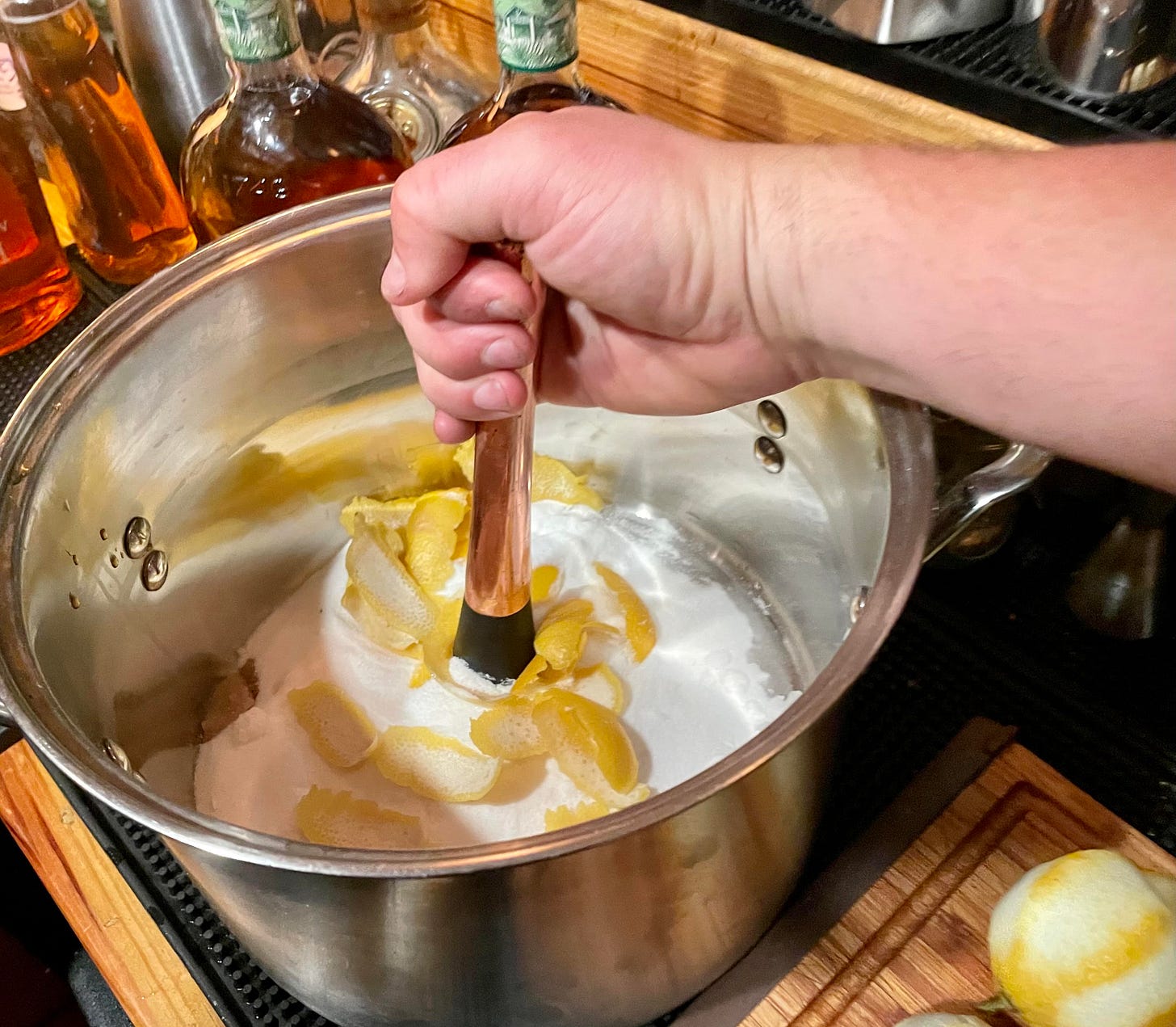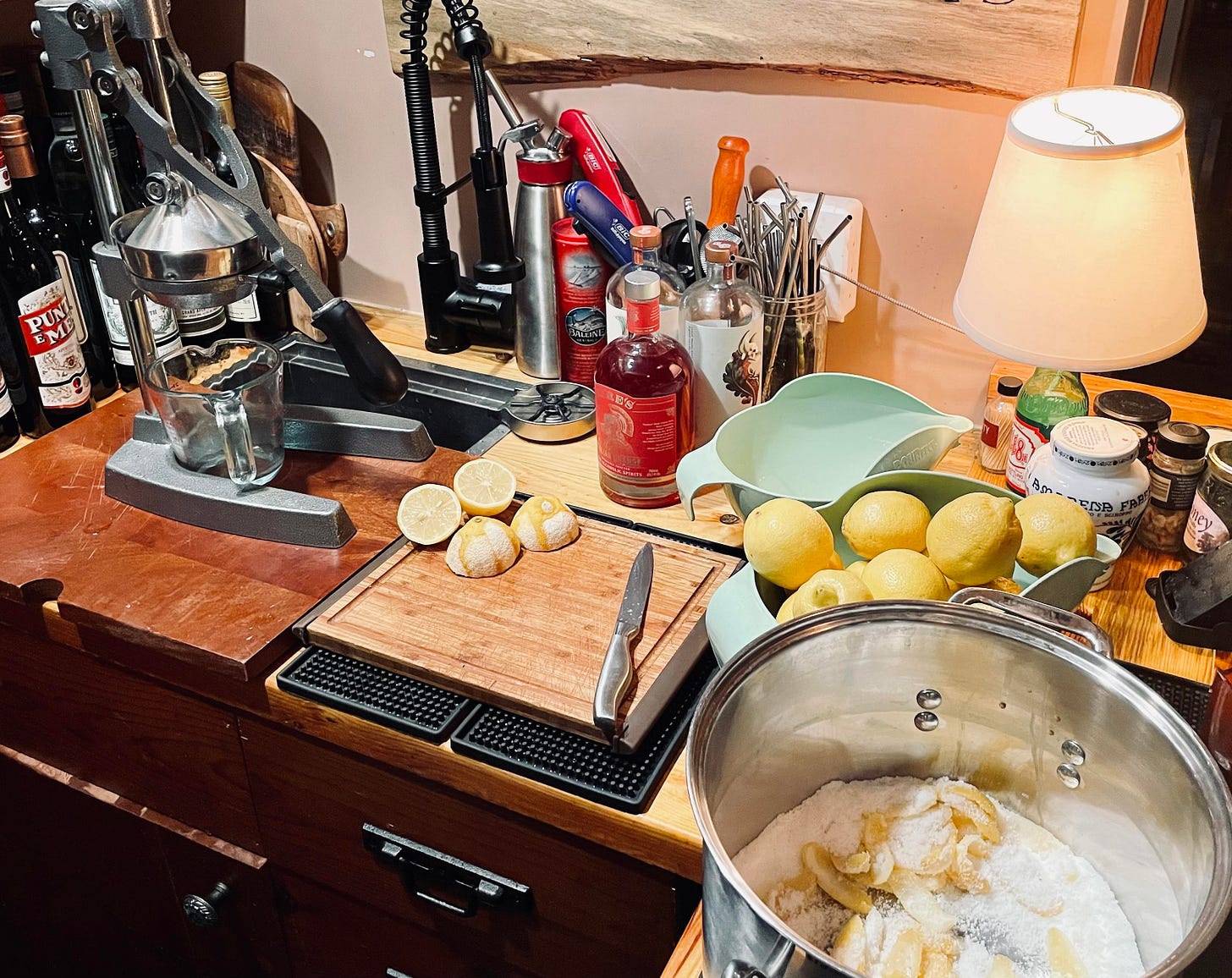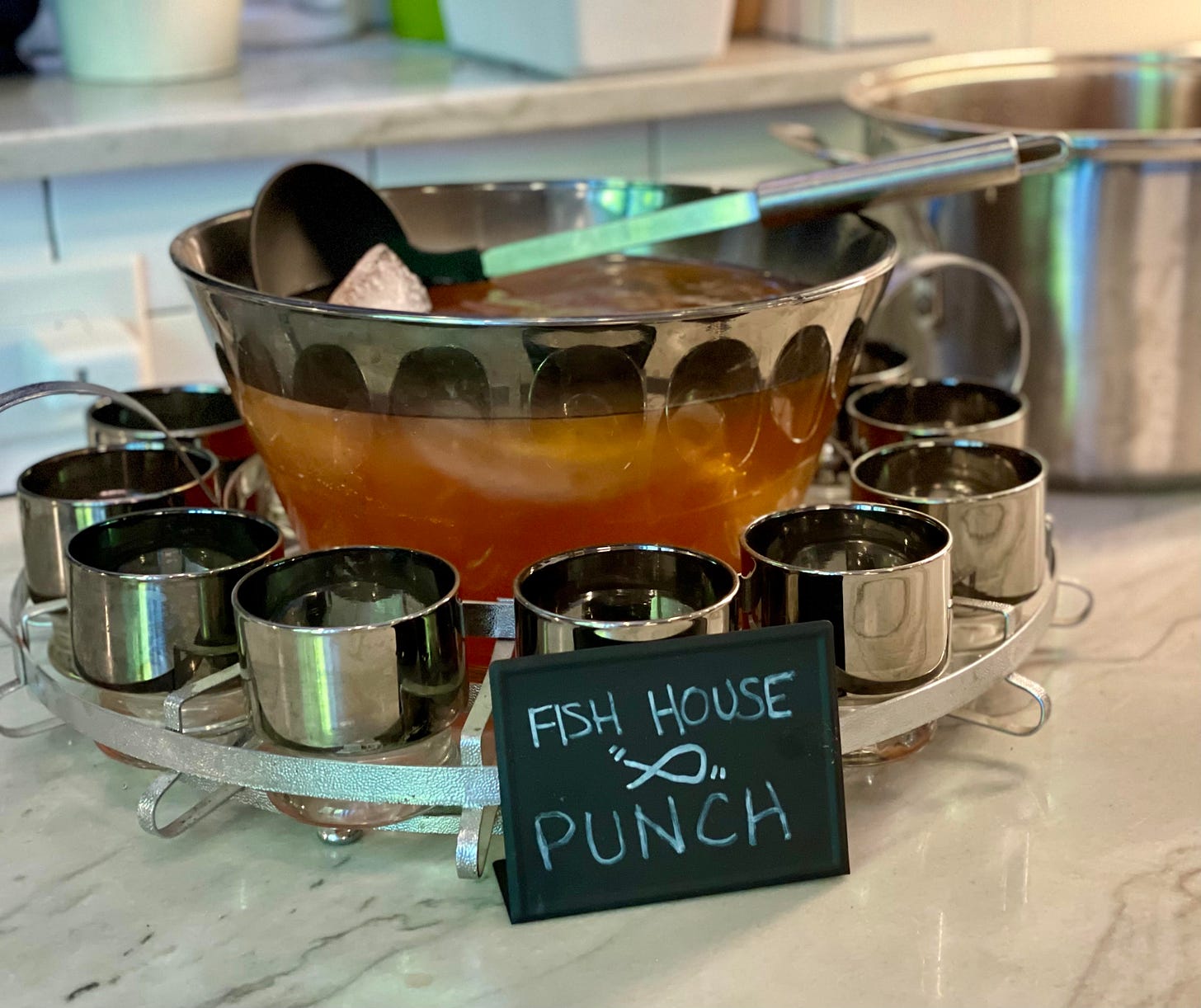Spend Your 4th of July Weekend Making (and Drinking) Philadelphia Fish House Punch
A great American drink for a great American holiday.
Happy 4th of July! This weekend, I’m making Philadelphia Fish House Punch for a big group of friends. I strongly suggest you do the same. This week’s newsletter is arriving a day early so you can prepare. And because it’s a holiday weekend, it’s going to the entire list.
I am frequently asked about batching cocktails for parties, and Fish House Punch is always the first drink I recommend. It’s subtle and fussy enough to please your favorite finicky cocktail obsessive, but it’s also quite accessible to normies who just want something cool and sweet to drink. It’s also designed to be made in batches, unlike a lot of single-serve sours, which lose their texture when not individually shaken. A single batch of Fish House Punch makes enough for a dozen or more people to drink throughout the night.
Philadelphia Fish House Punch is an old American punch that combines ingredients from all over the world: rum from Jamaica, cognac from France, tea from the United Kingdom, and, if you can find it, real peach brandy, which was a favorite of our Founding Fathers. (Plus, of course, lemons from wherever you ordinarily buy them — in my case, Trader Joe’s). It’s an American original — which of course means it’s constructed mostly from ingredients we shipped in from elsewhere, then mixed and matched and made our own. Americans have always been great synthesizers, and this punch is no exception.
The recipe is more than 225 years old, but it’s still delicious, still rich and boozy without coming on too strong, and still perfect for a hot summer afternoon or a starry July night as fireworks boom across the sky. Best of all, for those who plan to spend this weekend celebrating with friends and fellow countryfolk, it’s relatively easy to make in advance of a party — or bottle up and bring to a friend’s shindig. Your guests can serve themselves, leaving you free to roam, a delectable drink in hand.
The Power of Punch
It is quite probable that no living person has done more to advance the cause of historic punch, generally, and Philadelphia Fish House Punch specifically, than cocktail historian David Wondrich. In his 2010 book, Punch: The Delights (and Dangers) of the Flowing Bowl, Wondrich covers the origins and historical development of big, batched, spiritous drinks, typically consisting of a spirit or spirit blend — often but not always rum — plus citrus, sugar, and water. We won’t make his recipe down to the ounce, but his excellent and foundational work informs nearly all of my thinking on this drink.
You may notice that the ingredients look awfully familiar: In small doses, we’d ordinarily call something like this a sour. Presuming that the base spirit was strictly rum, we’d probably refer to it as a Daiquiri — or, at the very least, as Daiquiri-esque. But punch predates the cocktail as we know it, appearing several hundred years before the advent of the sort of single-serve mixed drinks this newsletter typically covers.
And, of course, one of the defining factors of punch is that it does not come in small doses. On the contrary, it’s meant to be made in large quantities, and consumed in them as well, often over the course of several hours. Punch is not just a conversation starter; it’s a conversation continuer — a communal companion that’s with you for the long haul. You’re meant to gather round and tend it for hours as it provides warmth in the winter, cool in the summer, and pleasant accompaniment all year round. Punch is a pleasurable way of passing the time.
Because punch comes in large quantities and is meant to be consumed generously over a long time frame, it requires more dilution than conventional single serve cocktails. The goal is not to knock yourself out after a few sips.
So the earliest recipe for Philadelphia Fish House Punch that I’m aware of, first published in 1795 and reprinted in Wondrich’s Punch, calls for making a syrup that requires 10 pints of water and four whole pounds of sugar. (This is not what anyone would call keto friendly.)
Several cups of this mixture — basically a big batch of syrup — is then blended with large portions of lemon juice, “Cognac brandy,” “Jamaica rum,” and “best peach brandy.” There’s obviously quite a lot of booze involved, some of it fairly high proof. But with all the non-alcoholic ingredients involved, the end result should be relatively low ABV — much closer to fortified wine or even beer than straight rum or brandy.
And over the course of the evening, you’ll dilute it even further. Unlike the single-serve cocktail, which is a precision operation where dilution must be exacting, punch, when served over a big chunk of ice, will evolve over time as ice melts and mellows the drink.
Every Old Fashioned you make should taste exactly the same (provided you’re using the same ingredients and structure), and with proper ice, should change only slightly from the first sip to the last. But your second glass of punch might well taste a little bit different from your third, or your fifth.
(And yes, a fifth drink is a possibility here. Over the course of a long evening, if you’re not driving, five small servings might be an almost reasonable amount to consume. Properly diluted and sipped slowly, it would represent a modest indulgence, but not necessarily a wildly irresponsible one.)
Punch, by its nature, is a more relaxed mixed-drink format. It does not demand very much from you — except that you enjoy yourself. In turn, you should not demand too much of your punch.
That amiable inexactitude, however, does not mean that you can be lazy or sloppy in your preparation. Punch is not hard to make. But it does require some care and effort in the hours before serving, and in the choice of ingredients. And that starts the night before, with the preparation of punchbowl ice, and continues the next day, with a mid-afternoon preparation of an old and somewhat unusual homemade ingredient: oleo saccharum.
Booze, Sugar, Citrus, Tea
To make Philadelphia Fish House Punch, you’ll need the following ingredients:
8 ounces (one cup) sugar
6 ounces honey syrup (3:1 honey:water, whisked thoroughly)
8-12 lemons
32 ounces black tea, made with 4-5 black tea bags
8 ounces fresh squeezed lemon juice
32 ounces Jamaican rum
16 ounces cognac or American brandy
4 ounces real peach brandy, or, if you can’t find the good stuff (see below), peach-flavored brandy
Ground nutmeg or cinnamon
A few notes on ingredients:
For the sugar, you can use ordinary white sugar, but some recipes do call for darker sugars, such as cane, turbinado, or demerara sugar. Those will produce a darker, richer punch.
For the rum, I like Appleton Estate Signature, which is inexpensive, easy to find, and delicious. For an upgrade, try Plantation Xaymaca, which is slightly pricier and has a somewhat more distinctive, complex flavor. For a bit more alcohol, try blending a few ounces of overproof Jamaican rum like Smith & Cross with the Appleton.
For the cognac, an ordinary bottle of Courvoisier VS or VSOP will do just fine. For an upgrade, try something like Hine H cognac. If you want something less expensive, you can substitute unflavored American brandy, like your trusty bottle of E&J (use VSOP or XO).
For the peach brandy: If you want to make this the “right” way, this will be the most difficult bottle to obtain. Sure, you can find bottles of Paul Masson Peach Brandy for $15 or less in most any liquor store in the country, and it will produce a tasty punch. But those inexpensive bottles are peach-flavored brandy.
What the original recipe calls for, however, is “best peach brandy.” And the peach brandy used at the time would have been brandy distilled from macerated peaches. It was a fruit-based eau de vie — almost a fruit whiskey — and it was a favorite spirit of America’s Founding Fathers, as well as a key ingredient in Fish House Punch.
A decade or two ago, it would have been nearly impossible to find such a thing. But now there are several distillers who make old style peach brandy. I keep a bottle from Catoctin Creek around. The George Washington Distillery at Mount Vernon also produces a limited edition bottling. These tend to be fairly expensive, but they are worth the price of entry. If you get one, make sure to try at least a sip or two on its own; this stuff is divine.
A Punch-Day Timeline
Making a big batch of punch is partly about technique, partly about ingredients, and partly about preparation timing. So instead of the usual numbered instructions, I’m going to provide a general timeline, starting with the night before.
The Night Before: Make a Big Block of Ice
If you’re making this for a party, you should begin about 24 hours beforehand by making a big block of rounded ice for your punchbowl. You can, of course, fill a punchbowl with ordinary refrigerator ice if that’s all you have. But this drink dilutes more slowly, and thus maintains somewhat more consistency, if you use a very big block of ice that acts as an island in the middle of the punchbowl. It also looks better. All you need to do is take a large tupperware-style plastic bowl or container and fill it with water, then leave it in the freezer overnight.
Early Afternoon: Make Oleo Saccharum, Lemon Juice & Tea
The next day, sometime during the early afternoon, you’ll start your oleo saccharum. Oleo saccharum is a mixture of sugar and crushed citrus peels intended to extract the highly aromatic citrus oil from the peels.
Think of it a little like a built-in garnish: When you twist or squeeze an orange or lemon peel over the top of a cocktail, you are spraying citrus oil over the top of your drink, altering the aroma and subtly flavoring the drink. An oleo saccharum does something similar, but built into the base mixture, and at scale. You’re flavoring the entire punch with the essence of lemon.
You only need to use four or five lemons here — the remaining lemons will be for juice. Simply strip the peels with a vegetable peeler. You don’t need to worry about removing every last bit of peel, but the lemons should be pretty thoroughly skinned. Do, however, try to cut thin slices that are mostly peel and don’t have thick sections of white pith attached.
Then combine the peels with the sugar in a large bowl, and gently muddle the peels and the sugar with a wooden spoon or muddler. You’re not trying to shred the peels; you’re just trying to crack the surfaces of the peels. After muddling, let the peels and sugar sit in a bowl for at least an hour, and preferably longer.
Next, make fresh juice, using both your newly stripped lemons and the remaining unpeeled lemons. The precise number of lemons you’ll need will vary, but typically a single lemon produces between 0.75 and 1 ounce of juice. Make sure to strain the solids from your juice. The goal is to produce 8 ounces of strained lemon juice. Store your strained juice in the refrigerator for the afternoon.
The last step at this point is to make a big batch of tea. Although it is possible to use plain old water in place of the tea — and the 1795 recipe does not call for tea — this punch will be much more flavorful and interesting with a big batch of black tea. You don’t need to use anything fancy; I keep packages of Twinnings English Breakfast around, and it works quite well. Just combine four black tea bags with 32 ounces of boiling water and let it sit for a while. If you are concerned about caffeine but still want the flavor of tea, you can use a green tea, or decaf.
Mid-Afternoon: Take a Break (and Check Your Tea)
Then go find something else to do. Sweep the floor. Set the buffet table. Create a party playlist. Read a delightful 2008 New Yorker feature about elevators. Play several rounds of Call of Duty. It’s entirely up to you.
Whatever it is you choose to do, you need to occupy yourself for at least an hour, and perhaps two or three. This time will let the lemon peels and sugar get to know each other (time heals all wounds, and extracts all essences).
During this time, the tea will also steep and cool. Yes, tea steeped for this long will be somewhat bitter by the time you’re done. If this concerns you — perhaps you are someone who is quite sensitive to bitter flavors? — you can pull the tea bags out after 15 or 20 minutes of steeping, then just let the tea cool for a while. But in my experience, a tea that’s steeped for quite a while works well, adding herbal warming spice and depth to the mix.
Late Afternoon: Combine the Main Ingredients
Roughly an hour before your guests arrive, combine the remaining ingredients except the honey syrup and the ice. Start by pouring the tea over the oleo saccharum. Gently whisk the mixture to combine the tea, sugar, and citrus peels. Then add the lemon juice, cognac, rum, and peach brandy. Stir to combine, then let sit on the counter.
When Your Guests Arrive: Add Ice and Spice — and Adjust the Sweetness
Once your guests start arriving, add the big block of ice you started making the night before. If you’re going to transfer the mix to a fancy punch bowl, this is the time to do it. (If the ice block breaks up, don’t worry about it.)
Then lightly cover the liquid with fresh-ground nutmeg, cinnamon, or both. You should get a distinct whiff of spice on the nose, but the spice flavor should not overpower the rest of the drink. Alternatively, you can add the ground spice to the top of each individual drink.
Finally, as you taste the punch over the course of the evening, consider adjusting the sweetness. The punch will be tasty from the first sip, but it will also be on the strong and dry side. As it dilutes, it will grow weaker, and a bit of added sweetness can punch it up.
That’s what the honey syrup is for. Adjusting the sweetness should be a patient, iterative process. Stir an ounce or two of honey syrup into the punchbowl, then taste the result, then keep going until you’ve reached the desired level of sweet. The punch shouldn’t be cloying, but it should be pleasant and easy to drink. When I made Fish House Punch for a group of friends last week, I ended up adding a total of about 6 ounces of honey syrup to the mix. Your preferred sweetness level may vary.
Punch is best served in small glasses, 2-4 ounces at a time.
Congratulations, you’ve just made a big bowl of punch. At the end of the night, you can bottle up any remainder and store it in the refrigerator for up to a week (make sure to strain out the lemon peels first.) But until then, the only task left is for you and your guests to enjoy the evening.
***
Cocktail Library: Punch: The Delights (and Dangers) of the Flowing Bowl, by David Wondrich. A delightful, deeply researched read on the history and nature of punch from the cocktail world’s foremost historian, this is an essential book for anyone who wants to study the history of mixed drinks and communal drinking.
(This newsletter relies on Amazon Affiliate links, through which I may earn a small commission.)









Catoctin Creek—the pride of Virginia!
If I had to sub Grand Marnier for the cognac (I live in PR, and sometimes the choices are slim), any idea how much I might want to reduce the sugar?